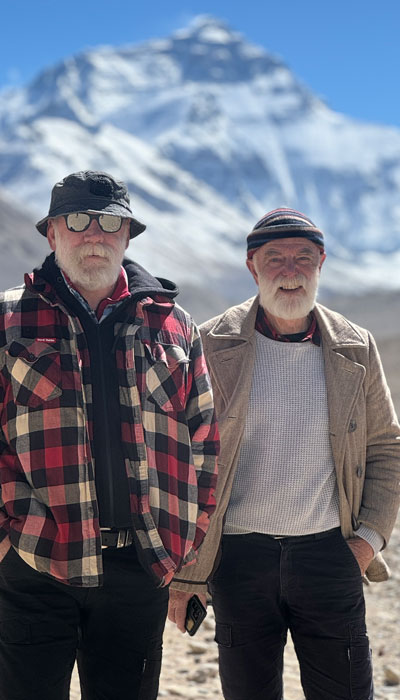Mount Everest is the highest mountain in the world, located in the Himalayas between Nepal and Tibet. Its summit is 8,848 meters (29,029 feet) above sea level. Mt. Everest has several different names.
In Tibetan name, it is called Qomolangmu.
In Chinese Name: Zhumu-Langma
In Nepalese Name: Sagarmatha;
In the 19th century, a British surveyor named: Peak XV
International Name: Mount. Everest, which was named after Sir George Everest.
Tenzin Norgay and Sir Edmund Hillary made the first expedition up the mountain in 1953. Since then, countless mountain climbers have attempted to reach the top. The climb is regarded as one of the most difficult and dangerous in the world due to extreme weather conditions, high altitude, and rough terrain. Adventurers from all over the world continue to be drawn to Everest despite the dangers.

The team, led by Wang Fuzhou, Qu Yinhua, and Tibetan climber Gonpo, summited Everest via the challenging North Ridge route on the Tibet side on May 25, 1960. This route, known for its technical difficulty, includes the infamous “Second Step,” a near-vertical rock face at 8,600 meters. Qu Yinhua famously removed his boots to climb this section barefoot due to ice, suffering severe frostbite that later cost him his toes.
Mount Everest is a sacred mountain for Tibetans and Nepalis; we named it Qomolangma and Sagarmatha, respectively.
Qomolangma is also the name of a Tibetan female deity who is part of Tsering Jie-Nga. It has significant spiritual and cultural significance for the Tibetan and Nepali people, and Mt. Everest is regarded as a symbol of identity and legacy. The mountain also provides an important source of livelihood for Tibetans and Nepalis, as many of them serve as guides, porters, and support staff for expeditions attempting to climb it.
The tourism business surrounding Mount Everest gives employment possibilities and economic benefits to the local populations that rely on it. The mountain is a top destination for travelers traveling to Tibet, which aids in highlighting the area’s culture, history, and natural beauty. Overall, Mount Everest plays an essential part in Tibetans’ lives, both spiritually and economically.
Mount Everest’s history begins in the early twentieth century when British surveyors, explorers, and mountaineers began exploring the Himalayan region. In 1921, a British expedition led by George Mallory attempted but failed to reach the top. Mallory attempted a second attempt in 1924, but he vanished during the ascent, and they did not discover his body until 1999.
Tenzing Norgay, a Sherpa from Nepal, and Sir Edmund Hillary, a climber from New Zealand, were the first people to successfully climb Mount Everest in 1953. Their historic achievement was widely publicized and marked a significant step in mountaineering history.
Since then, many climbers from all over the world have tried their best to climb Mount Everest, with varied degrees of success. Many climbers have perished on the mountain throughout the years, and its extreme weather and high altitude make it one of the most difficult and dangerous climbs in the world.
In recent years, there has been an increasing worry about the influence of tourism on Mount Everest and the surrounding region. The Chinese and Nepalese governments have taken measures to control the number of climbers and enhance safety precautions on the mountain, but the difficulties in managing such a well-known and recognizable location continue to be a source of worry.
The Tibet side of Mount Everest is known as the North Face or “North Ridge. The vista of Mt. Everest is spectacular. It is the easiest way to get to Mt. Everest Base Camp, as you drive up to Everest Base Camp, which is close to the Rongbuk Monastery (the world’s highest monastery, at an elevation of 4,980 meters). Everest Base Camp (EBC) is also the world’s most popular site, with a panoramic view of Mt. Everest from an elevation of 5,200 meters.
At 8,848.86m, Nepal’s Sagarmatha lies in Sagarmatha National Park. Treks begin in Lukla, winding through Sherpa villages, forests, and monasteries to Everest Base Camp. Climbers brave the Khumbu Icefall, altitude, and environmental threats like glacial melt. Balancing adventure with Sherpa heritage and conservation, the Nepal side offers majestic Himalayan vistas, embodying humanity’s quest to conquer nature’s pinnacle.

The optimal time to visit Mount Everest is during spring (April–May) or autumn (September–October). These seasons offer stable weather, clear skies, and mild temperatures (5–20°C), ideal for trekking and photography. Spring brings blooming rhododendrons in Nepal, while autumn showcases golden foliage in Tibet. Both periods avoid monsoon rains and extreme cold, though trails can be busy with climbers preparing for summit attempts.
Winter (December–February) and summer/monsoon (June–August) are less popular but cater to specific travelers. Winter offers solitude and crisp mountain views, though temperatures drop to -25°C, and snow may block routes. Summer brings heavy rain to Nepal, creating slippery trails, while Tibet experiences lighter rainfall and lush landscapes. These seasons suit budget travelers or adventurers seeking unique challenges.
Regional Tips: For Nepal’s south side, focus on March–May or September–November. In Tibet, prioritize April–May or September–October, avoiding March due to permit uncertainties. Secure permits early, acclimatize to altitude, and pack layered clothing for temperature swings. Whether chasing Himalayan vistas or cultural immersion, timing ensures a safer, more rewarding journey.
Mount Everest sits majestically on the border between Nepal and China, specifically in the Himalayas. Its summit officially rests within Nepal, while the lower slopes extend into China (Tibet Autonomous Region).
Here’s a breakdown:
The best visiting and trekking seasons are spring (April-May) and autumn (September-October), offering pleasant temperatures and clear skies.
For Visiting and trekking to Everest Base Camp (Tibet):